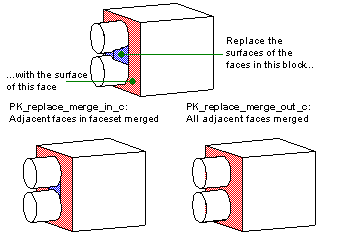 |
Local Ops: Tweaking the Surfaces of Faces |

Local Ops: Tweaking the Surfaces of Faces
| <<< Local Ops: Creating Surfaces to Attach to Faces | Chapters | Local Ops: Transforming Faces >>> |
You can use PK_FACE_replace_surfs_3 to change the diameter of a hole, as in the following example:

Figure 17-1 Tweaking a single face
You can use PK_FACE_replace_surfs_3 to change the top (planar) face of a cylinder to a sphere and change its cylindrical face to a truncated cone, in the same operation.

Figure 17-2 Tweaking a list of faces
Sometimes, replacing the surfaces of selected faces means that adjacent faces that were previously not mergeable can now be merged. You can control whether or not such merging is performed using the
merge
option (PK_replace_merge_t) in PK_FACE_replace_surfs_o_t. This option can take the following values:
This is illustrated in Figure 17-3.

Figure 17-3 Merging adjacent faces when replacing surfaces
Figure 17-4 shows a block with two slots where four faces share a single planar surface. Tweaking one of the four faces that share the top planar surface, independently of the others, results in that face being detached from the original shared surface and therefore given a new surface. The remaining three faces still share the original geometry. The same applies to the shared curves.

Figure 17-4 Shared surface after a PK_FACE_replace_surfs_3 operation
PK_FACE_replace_surfs_3 allows a wide range of topology changes. However, there are a number it cannot handle. The following attempted operations, illustrated using the previous examples, fail for the reasons as explained.
This following operation fails because the edges at the top and bottom cannot be recalculated. This is because the cylindrical surface no longer intersects the top/bottom faces.

Figure 17-5 Change in topological relationship between top face and hole
This following operation fails because the face of the hole has been tweaked to such an amount that it has split the planar faces, thereby creating two solids in the model.

Figure 17-6 Topological change - hole splits the planar faces
This following operation fails because the tweak that was applied to the cylindrical face would result in a pointed cone being created. The edge at the bottom of the cylinder cannot be recalculated since the new surface (cone) does not intersect the bottom (planar) face.

Figure 17-7 Topological change - the bottom planar face has been deleted
To successfully complete the previous three examples you need to use boolean operations.
| <<< Local Ops: Creating Surfaces to Attach to Faces | Chapters | Local Ops: Transforming Faces >>> |